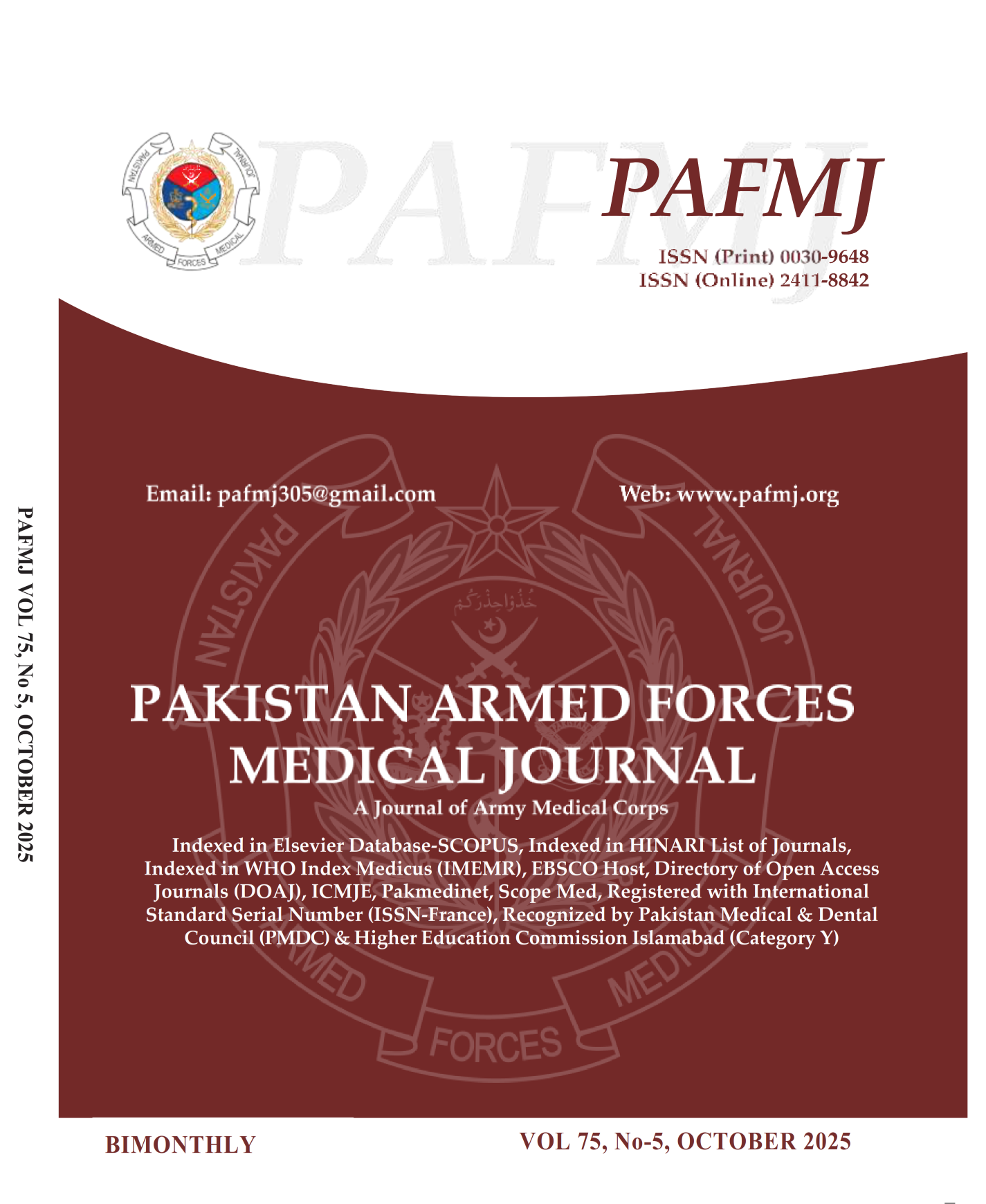Comparison of Spot Urine vs 24-Hours Urine in Assessment of Proteinuria in Patients with Type 2 Diabetes Mellitus
DOI:
https://doi.org/10.51253/pafmj.v75i5.10722Keywords:
Albuminuria, Diabetes Mellitus, Nephropathy, Proteinuria, Spot uPCR, 24 Hour Urine ProteinAbstract
Objective: To assess the correlation between spot urine test (Spot Protein/Creatinine Ratio) and 24-hours urine protein analysis in assessing proteinuria among patients with Type 2 diabetes.
Study Design: Cross-Sectional Study.
Place and Duration of Study: Department of Medicine, Combined Military Hospital, Abbottabad Pakistan, from Oct 2022 to Mar 2023.
Methodology: Eighty patients of either gender with diagnosed Type 2 Diabetes Mellitus presenting to CMH Abbottabad during study period with evidence of proteinuria were included in the study. 24-hours urine sample was obtained for analysis of 24 hours protein excretion. Urine was also tested for spot protein creatinine ratio in all patients. Association of 24-hour urine and spot urine protein levels was observed and represented by ROC curve and Pearson's correlation.
Results: Total 80 diabetic patients with proteinuria analyzed with mean age of 53.51±6.34 years including 45(56.3%) males and 35(43.8%) females. The mean duration of diabetes was 7.75±1.95 years with mean fasting sugar 183.88±36.33 mg/dL and HbA1c 9.46±1.30%. The observed mean 24-hour urinary protein was 1194.60±398.39 mg/day and mean spot uPCR was 1005.49±446.84 mg/mmol. An affirmative correlation was noted in 24-hours urine protein and uPCR (r value= 0.604; p<0.001). The ROC curve with respect to age groups showed p=0.143 and =0.851 for 24-hours urine protein and spot uPCR respectively.
Conclusion: 24-hour urinary protein and urine protein/ creatinine ratio (uPCR) were equally reliable for proteinuria detection in patients with Type 2 diabetes mellitus. However, spot uPCR is fast, convenient and easily available substitute for 24-hour urine protein in healthcare facilities.
Downloads
References
1. Khan R, Chua Z, Tan J, Yang Y, Liao Z, Zhao Y. From Pre-Diabetes to Diabetes: Diagnosis, Treatments and Translational Research. Medicina 2019; 55(9): 546.
https://doi.org/10.3390/medicina55090546
2. Azeem S, Khan U, Liaquat A. The Increasing Rate of Diabetes in Pakistan: A Silent Killer. Annals Med Surg 2022; 79: 103901.
https://doi.org/10.1016/j.amsu.2022.103901
3. Imam AA, Saadeh S A. Evaluation of Proteinuria and Hematuria in Ambulatory Setting. Pediatr Clin North Am 2022;69 (6): 1037–1049. https://doi.org/10.1016/j.pcl.2022.07.002
4. Haider MZ, Aslam A. Proteinuria. In StatPearls; StatPearls Publishing: Treasure Island (FL), 2024.
5. Bökenkamp A. Proteinuria—Take a Closer Look! Pediatr Nephrol 2020; 35(4): 533–541.
https://doi.org/10.1007/s00467-019-04454-w
6. Williams ME. Diabetic Nephropathy: The Proteinuria Hypothesis. Am J Nephrol 2005; 25(2): 77–94.
https://doi.org/10.1159/000084286
7. Jun M, Ohkuma T, Zoungas S, Colagiuri S, Mancia G,Marre M, et al. Changes in Albuminuria and the Risk of Major Clinical Outcomes in Diabetes: Results From ADVANCE-ON. Diabetes Care 2018; 41(1): 163–170.
https://doi.org/10.2337/dc17-1467
8. Tanacan A, Fadiloglu E, Beksac M. The Importance of Proteinuria in Preeclampsia and Its Predictive Role in Maternal and Neonatal Outcomes. Hypertens Pregnancy 2019; 38(2): 111–118.
https://doi.org/10.1080/10641955.2019.1590718
9. Aitekenov S, Gaipov A, Bukasov R. Review: Detection and Quantification of Proteins in Human Urine. Talanta 2021; 223: 121718.
https://doi.org/10.1016/j.talanta.2020.121718
10. Kobayashi S, Amano H, Terawaki H, Ogura M, Kawaguchi Y, Yokoo, T. Spot Urine Protein/Creatinine Ratio as a Reliable Estimate of 24-Hour Proteinuria in Patients with Immunoglobulin A Nephropathy, but Not Membranous Nephropathy. BMC Nephrol 2019; 20(1): 306.
https://doi.org/10.1186/s12882-019-1486-8
11. Abubacker N, Abubacker S, Rajendran K, Jayaraman S, Suthakaran P, Kalappan M. A Comparative Study of Spot Urine versus 24 Hour Urine in Assessment of Proteinuria in Varying Degree of Renal Dysfunction. Int J Adv Med 2016; 1–4.
https://doi.org/10.18203/2349-3933.ijam20151532
12. D’Aguilar SK, Skandhan A Southeast Health Medical Center, 1108 Ross Clark Circle Dothan AL 36301, USA. Proteinuria: A Guide to Diagnosis and Assessment. Intern Med Open J 2020; 4(1): 3–9. https://doi.org/10.17140/IMOJ-4-112
13. Kamińska J, Dymicka-Piekarska V, Tomaszewska J, Matowicka-Karna, J, Koper-Lenkiewicz O. M. Diagnostic Utility of Protein to Creatinine Ratio (P/C Ratio) in Spot Urine Sample within Routine Clinical Practice. Crit Rev Clin Lab Sci 2020; 57(5): 345–364.
https://doi.org/10.1080/10408363.2020.1723487
14. Leung A, Wong A, Barg N. Proteinuria in Children: Evaluation and Differential Diagnosis. Am Fam Physician 2017; 95(4): 248–254.
15. Molefe-Baikai O, Molefi M, Cainelli F, Rwegerera G. The Prevalence of Microalbuminuria and Associated Factors among Patients with Type 2 Diabetes Mellitus in Botswana. Niger J Clin Pract 2018; 21(11): 1430.
https://doi.org/10.4103/njcp.njcp_224_18
16. Yang F, Shi JS, Gong SW, Xu X, D Le. An Equation to Estimate 24-Hour Total Urine Protein Excretion Rate in Patients Who Underwent Urine Protein Testing. BMC Nephrol 2022; 23(1): 49.
https://doi.org/10.1186/s12882-022-02673-2
17. Ying T, Clayton P, Naresh C, Chadban S. Predictive Value of Spot versus 24-Hour Measures of Proteinuria for Death, End-Stage Kidney Disease or Chronic Kidney Disease Progression. BMC Nephrol 2018; 19(1): 55.
https://doi.org/10.1186/s12882-018-0853-1
18. Nazia S, Shaikh F, Ameer N, Abbasi A, Razzaq A, Ahsan M et al. Comparing Spot Urine Protein: Creatinine Ratio 24-Hour Urinary Protein Estimation in Type 2 Diabetes Mellitus Patients. J Pharmaceutical Res Int 2022; 26–32.
https://doi.org/10.9734/jpri/2022/v34i17A35760
19. Savith A, Prasad K. Estimation of Proteinuria in Type 2 Diabetes Mellitus: Is Spot Urine Protein-Creatinine Ratio as Efficacious as 24 Hours Urinary Protein? Int J Contemporary Med Res 2018: 5(12).
https://doi.org/10.21276/ijcmr.2018.5.12.28
20. Vadher A, Vora C, Chandpa J, Malviy Y, Chudasama, G. Correlation Of Spot Urine Protein/Creat Ratio And 24-Hour Urinary Protein For Proteinuria Estimation In Diabetic Nephropathy. Eur J Biomed Pharmaceutical Sci 2022; 9(2): 160-166.
21. Raza A, Nawaz S, Rashid R, Ahmed E, Mubarak M. The Correlation of Spot Urinary Protein-to-Creatinine Ratio with 24-h Urinary Protein Excretion in Various Glomerulopathies. World J Nephrol 2023; 12(5): 159–167.
https://doi.org/10.5527/wjn.v12.i5.159
22. Sahu S, John J, Augusty A. Estimation of 24 h Urine Protein Versus Spot Urine Protein Creatinine Ratio in Patients with Kidney Disease. Ind J Clin Biochem 2022; 37(3): 361–364.
Downloads
Published
Issue
Section
License
Copyright (c) 2025 Muhammad Zain Abideen, Rizwan Yusuf, Zaboor Barki, Muhammad Ali Khan, Nadeem Umar, Minahil Nadeem

This work is licensed under a Creative Commons Attribution-NonCommercial 4.0 International License.















